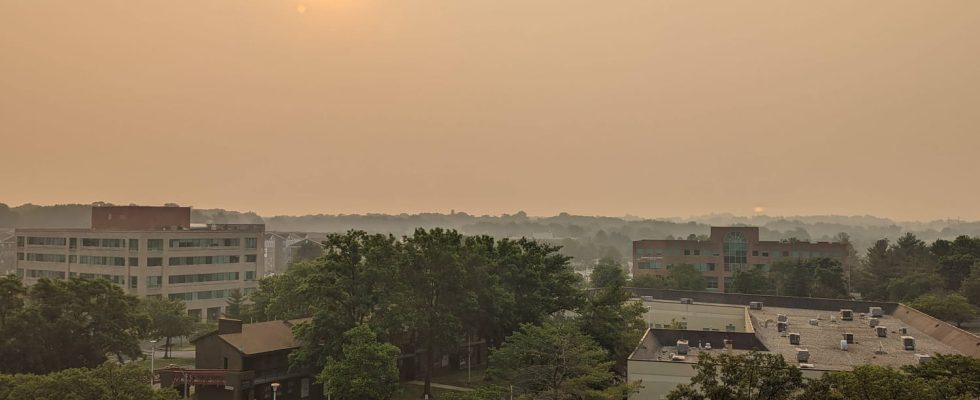A cloud of smoke from fires in Canada will hover over France this week. Here are the French territories concerned and the recommendations in the event of exposure to these ashes…
You will no doubt find sunrises and sunsets very hazy this week. A thick fog of ash will soon affect Europe, starting this Tuesday, June 27, 2023. These particles come from the hundreds of forest fires that have been raging in Canada since May and which have caused a huge cloud of ash, crossing the Atlantic.
This cloud of smoke from Canada will cross France between Tuesday and Thursday, according to weather forecasts from reference institutes. And it should not go unnoticed. For several days, the north-east of Canada and the United States have been living in a surreal atmosphere because of this phenomenon. Montreal even recorded the worst air quality in the world on Sunday June 25, according to Iqair, a Swiss agency specializing in the study and measurement of air pollution.
Covered in a thick veil of acrid smoke, the Quebec metropolis had to cancel several demonstrations and encourage residents to stay at home or, failing that, to wear a mask outside. The fog could hamper breathing or sting the eyes according to testimonies collected by AFP. France will also experience this phenomenon, with an intensity still unknown.
This interactive map of Copernicus (a European Union program on the state of the Earth) allows you to follow in real time the course of the ash cloud on the continent and therefore on France:
When will the cloud of smoke from Canada cross France?
The westernmost parts of the European continent should be affected by the ash cloud from this Tuesday, June 27 in the morning, according to forecasts by several institutes, including Keraunos. France and in particular Brittany should be the first affected according to the simulation established by the Copernicus program. The cloud should then move towards Normandy and Hauts-de-France to reach the Paris region on Wednesday and reach the center of the country at the end of the day.
The most affected day will be Thursday, June 29 with a mass crossing the whole country from West to East during the day, with more than three-quarters of the country affected and probably the highest concentrations. The ash cloud will still be present in the east of the country on Friday morning before evaporating.
Which departments will be most affected by the ash cloud?
If Brittany will be hit first on Tuesday, followed by Normandy and the departments bordering the Channel to the North Sea, the whole country should be crossed by the cloud of smoke. The southernmost regions could be relatively spared, with still high uncertainty. The winds could modify the trajectory and the altitude of this cloud of smoke.
According to Charlotte Lepitre, a manager of Atmo France, the organization that federates approved air quality monitoring associations, it is indeed difficult to predict which parts of French territory will be most affected by this phenomenon: “The wind speeds and precipitation in the North Atlantic area can change the game on the amount of particles that will reach us”, she explains to TF1info. “Thanks to the stations, we have data in real time and we can inform the population in the event of an increase in the concentrations detected in the air”.
Air quality affected in France
A tweet published this Monday by climatologist Serge Zaka shows it: the ash cloud is so dense that it is visible over the Atlantic from space. A strong flow allowed these fumes to cross the northern part of the ocean to the Old Continent. But the distance between Canada and Europe will probably avoid the high concentrations of particles identified in North America.
Meteorologists also predict that the majority of the smoke will remain at high altitudes. But the quality of the air could still be affected locally by the passage of these ashes. This map of Copernicus estimates the level of carbon monoxide present in these ashes: the concentrations of this toxic gas should be close to the limit of the critical threshold according to European criteria.
Here are the recommendations to follow, according to theARS Pays de la Loirefor “populations residing in areas farther from the fires, but where dense smoke from forest fires nevertheless reaches”:
- Limit travel and time spent outdoors
- Give up outdoor activities involving physical exertion
- Keep the doors and windows of the dwellings closed; ventilate again only after the effective dissipation of the fumes
- Maintain good indoor air quality in the home by not lighting any source of combustion (cigarette, candle, incense, etc.)
- Pay attention to people at risk, because the irritation of their respiratory tract by the fumes can aggravate their pathology.
- In the event of simple discomfort felt (perception of burning odor), it is not useful to solicit, neither your attending physician, nor to call the emergency number of the SAMU.
